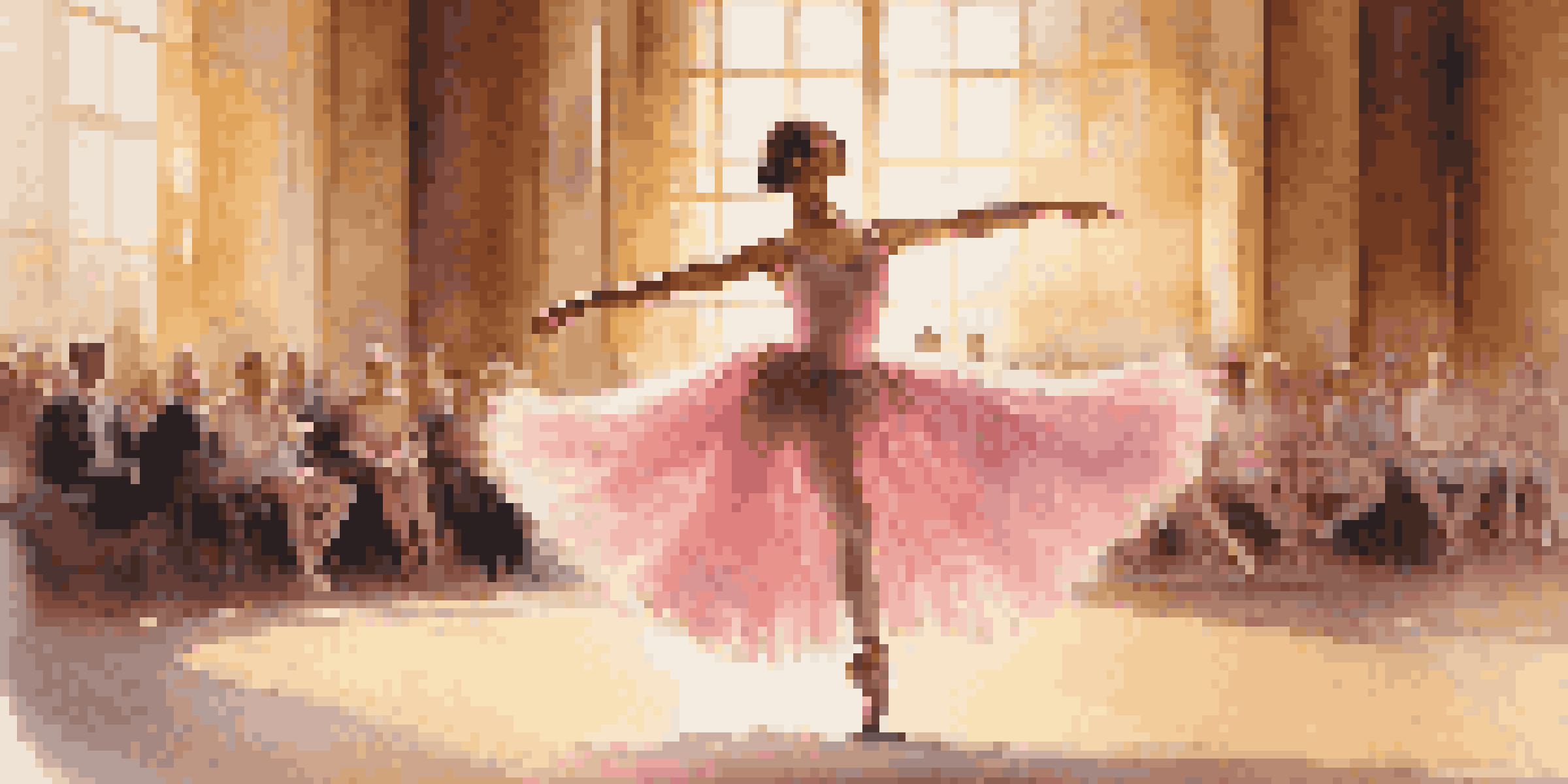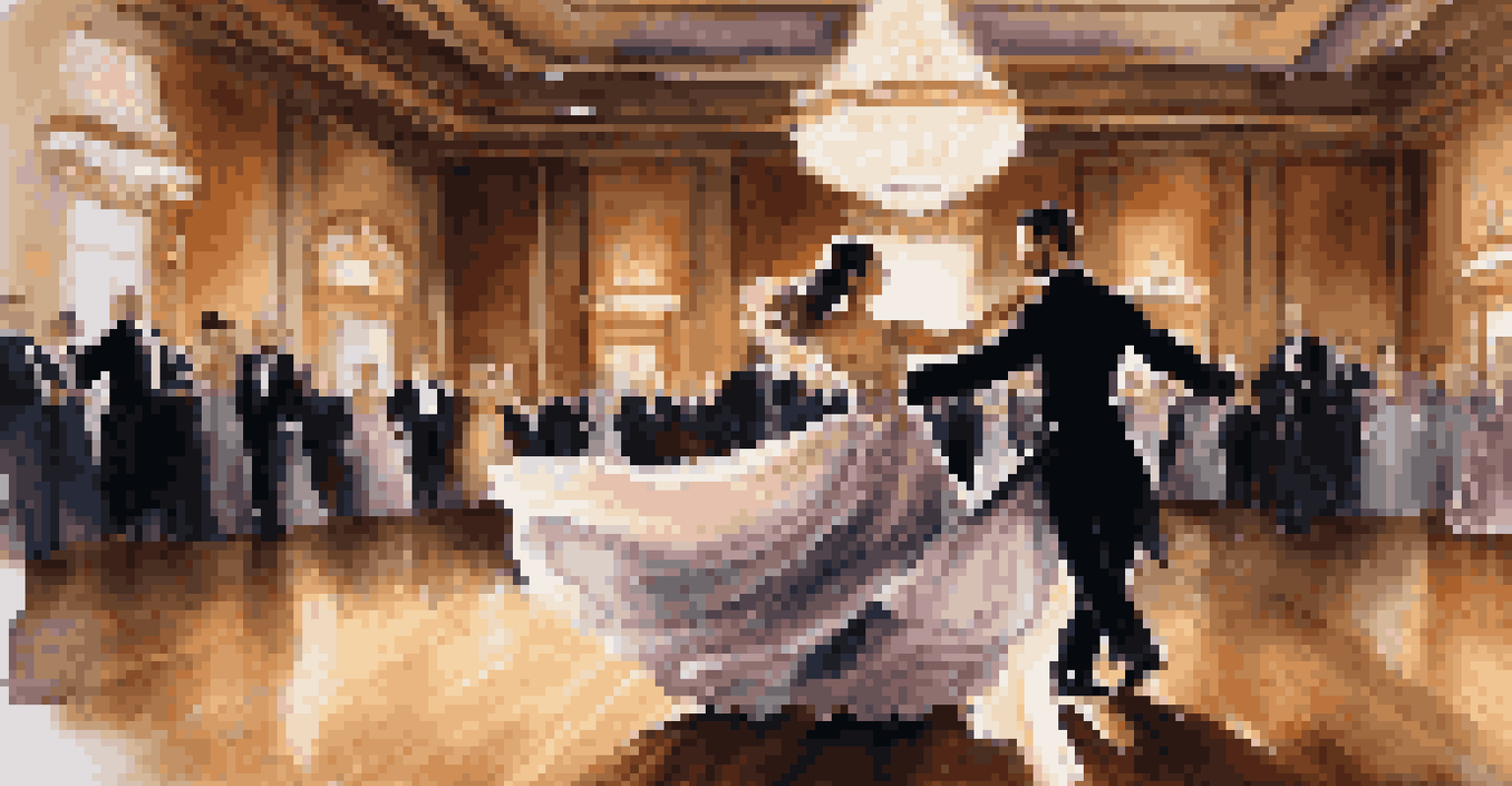The Role of Costumes in Dance Competitions: Style vs. Function

The Importance of Costumes in Dance Competitions
Costumes play a pivotal role in dance competitions, serving as a visual representation of the performance. They not only enhance the aesthetic appeal but also help convey the story or theme of the dance. Think of a ballet dancer in a flowing tutu versus a hip-hop dancer in streetwear; each outfit reflects the spirit of the respective styles.
Dance is the hidden language of the soul.
Moreover, a well-chosen costume can boost a dancer's confidence, allowing them to embody their character fully. When a performer feels good in their outfit, it often translates into a more engaging performance. This connection between costume and confidence is vital in competitive settings where every detail matters.
However, the role of costumes goes beyond just looks; they must also support the dancer's movements. A costume that restricts movement can hinder performance, while one designed for flexibility can enhance it. Thus, the balance between style and function is essential for success in dance competitions.
The Evolution of Dance Costumes
Dance costumes have evolved significantly over the years, reflecting cultural shifts and advancements in fashion. In the past, elaborate costumes were the norm, often incorporating heavy materials and intricate designs. However, modern dance competitions have seen a shift towards lighter, more functional outfits that allow for greater freedom of movement.

This evolution also mirrors changes in dance styles themselves. For instance, contemporary dance often features minimalistic costumes that focus on the body and movement rather than elaborate design. This trend highlights the dancer's physicality, showcasing their technique and artistry without distraction.
Costumes Boost Dance Performance
Well-chosen costumes enhance a dancer's confidence and are crucial for conveying the performance's theme.
Furthermore, the rise of social media and streaming platforms has influenced costume choices, with performers seeking to create visually striking looks that will stand out online. This has encouraged innovation in costume design, blending traditional elements with contemporary trends to captivate audiences both live and virtual.
Balancing Aesthetics and Movement
Finding the right balance between aesthetics and movement is crucial in costume design for dance competitions. While a stunning outfit can draw attention, it should never come at the expense of a dancer’s ability to perform. Dancers need to move freely, and their costumes must accommodate jumps, turns, and other dynamic movements.
The costume must be a part of the dance, not just something to wear.
Costume designers often face the challenge of creating visually appealing outfits while ensuring practicality. For example, a costume might be adorned with sequins for sparkle, but if those sequins catch on fabric or restrict movement, it can lead to performance issues. Thus, a successful costume strikes a perfect harmony between eye-catching design and functional wear.
Additionally, considering the type of dance is vital when balancing these elements. A jazz dancer may benefit from a fitted costume that allows for quick movements, while a ballroom dancer might require a more flowing design to accentuate their partner work. Each style has unique needs that must be addressed in the costume's design.
Costume Trends in Competitive Dance
Costume trends in competitive dance are constantly evolving, influenced by everything from popular culture to fashion runways. In recent years, there has been a noticeable shift towards bold colors and patterns, creating eye-catching visuals that stand out on stage. This trend not only captures attention but also reflects the personalities of the dancers wearing them.
Additionally, the use of technology in costume design has become increasingly popular. Costumes with LED lights or changing colors can add an exciting dimension to performances, making them more memorable. This innovation allows dancers to push creative boundaries, offering fresh experiences for judges and audiences alike.
Trends Shape Costume Design
Costume trends in competitive dance evolve with cultural influences and technological advancements, impacting visual appeal.
However, while trends can enhance a performance, it’s essential for dancers to choose costumes that align with their style and technique. A trend may not suit every dancer, and it’s crucial to prioritize individual expression over simply following the latest fads.
The Impact of Cultural Influences on Costumes
Cultural influences play a significant role in shaping dance costumes, as they reflect the heritage and traditions of various dance styles. For instance, traditional Indian dance costumes often feature intricate embroidery and vibrant colors, honoring the cultural significance of the dance form. This connection to culture helps to tell a story and enriches the performance.
Moreover, as dance has become more globalized, there’s been a blend of styles and influences in costume design. Dancers may incorporate elements from different cultures into their outfits, creating a fusion that showcases diversity and creativity. This blending can be particularly exciting in competitive settings, where originality is highly valued.
However, it’s essential to approach cultural elements with respect and understanding. Dancers and costume designers should ensure that they honor the traditions they draw inspiration from, avoiding appropriation and celebrating the richness of the culture through their performances.
Costume Maintenance and Care for Competitors
Maintaining and caring for dance costumes is crucial for competitors, as a well-kept outfit can make a significant difference in performance. Regular cleaning and proper storage help preserve the costume's appearance and functionality. Dancers should follow specific care instructions, especially for delicate fabrics or intricate designs, to ensure their costume remains stage-ready.
Additionally, having backup costumes is a smart move for any serious competitor. Accidents can happen—rips, stains, or other mishaps can occur right before a performance. Having a spare costume ensures that dancers can handle unexpected situations without losing confidence or composure on stage.
Future Focus on Sustainability
The future of dance costumes will likely emphasize individuality, creativity, and eco-friendly practices.
Finally, incorporating a pre-performance routine that includes checking costumes for any last-minute adjustments can help ease nerves. A simple check for loose sequins, proper fit, and overall appearance can go a long way in ensuring a dancer feels confident and ready to shine when it's time to perform.
The Future of Costumes in Dance Competitions
As we look to the future, the landscape of dance costumes in competitions is likely to continue evolving. With advancements in materials and technology, we might see even more innovative designs that enhance performance without sacrificing style. Think about costumes that adapt to the dancer’s movements or change colors mid-performance; the possibilities are exciting.
Additionally, the influence of sustainability is becoming more prominent in costume design. Dancers and designers are increasingly seeking eco-friendly materials and practices, contributing to a more sustainable approach in the dance world. This shift not only benefits the environment but also resonates with audiences who value responsible choices.

Ultimately, the future of dance costumes will likely emphasize individuality, creativity, and functionality. As dancers continue to push boundaries and redefine their art, their costumes will reflect their journey, making each performance a unique expression of style and function.